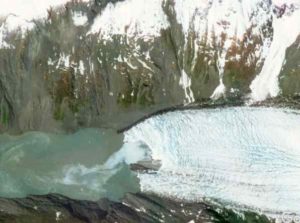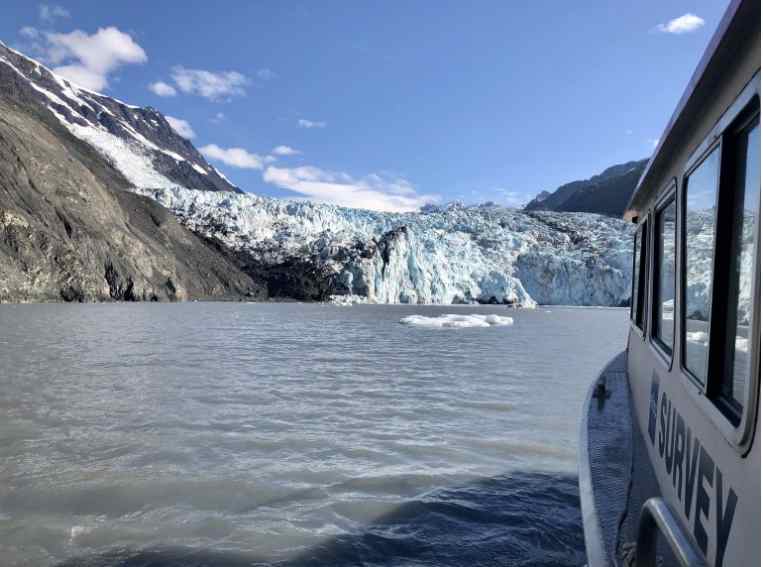
(Anchorage) — The threat of a large and potentially dangerous tsunami is looming in Prince William Sound, where an increasingly likely landslide could generate a wave with devastating effects on fishermen and recreationalists using the area, the state’s top geologist said.
Steve Masterman, director of the Division of Geological and Geophysical Surveys (DGGS) said his staff, in collaboration with a multi-institute working group, has received indications that the rapid retreat of the Barry Glacier from the Barry Arm, 28 miles northeast of Whittier, could release millions of tons of rock into the Harriman Fiord, triggering a tsunami at least as large as some of the largest in the state’s recorded history.
“The most noteworthy of these tsunamis was in 1958, when a landslide entered the Lituya Bay Fiord in Glacier Bay and generated a wave that went 1,700 feet up the opposite side of the fiord,” Masterman said. “The most recent was at Southeast Alaska’s Taan Glacier in 2015, where a wave went 600 feet up the opposite wall of the glacial valley.”
The rock masses released in those slides were at least a tenth of the size of the potential slide in Barry Arm, Masterman said. That assessment is based on calculations and comparisons with the previous tsunamis, where geologists have studied the pre-slide topography, the geometry of the outfall, the presence of scarring, and other data, then compared it with data about the Barry Arm region.
[content id=”79272″]
Geologists know the Barry Arm area as part of the “accretionary prism,” where plate tectonics forced sedimentary rocks to merge with the southern shore of the Alaska mainland long ago in geological history. The process created numerous faults and cracks, and subsequent formation and movement of glaciers further fractured and eroded the landscape. As glaciers retreat, they remove support of the valley walls, allowing the rockfalls and landslides that can create tsunamis when they enter water.
While it’s not possible to predict a landslide with precision, significant rainfall, snowfall or seismic activity — or a combination of any such effects — could precipitate a landslide event, and the continuing glacial retreat increases the odds as well, Masterman said.
“As global warming continues to thaw glaciers and permafrost, landslide-created tsunamis are emerging as a greater threat — not just in Alaska, but in places like British Columbia and Norway,” said Woods Hole Research Center (Massachusetts) scientist Dr. Anna Liljedahl.
DGGS’ mission is both to generate information on state mineral resources and to protect Alaskans from geologic hazards. Division geologists became aware of the potential for landslide in the Barry Glacier area when researchers at Woods Hole performing routine comparisons of two different sets of national geographical elevation data saw significant movement in the area, and notified DGGS about two weeks ago.
The region attracts many boaters engaging in commercial, sport, personal use or subsistence fishing and shrimping, as well as recreational boaters and campers, said Rick Green, special assistant in the Alaska Department of Fish and Game. In the summer, as many as 500 people may be in the area at one time, and at risk from a landslide-induced tsunami.
The attached map of the region shows the potential landslide site, as well as zones of both high and lesser danger. Both DNR and ADFG officials strongly recommend people avoid all the identified danger zones until the hazards can be adequately understood and characterized.
[content id=”79272″]
DGGS will work with a number of other scientific institutions and agencies to better understand the region’s bathymetry and geology, to help create better models to predict how large a tsunami might be and how it would propagate through the fiord and through the entire Sound.
Those institutions and agencies include the USDA Forest Service, which manages the land surrounding the Barry Arm as part of the Chugach National Forest; the U.S. Geological Survey, the federal agency responsible for monitoring the geology and geologic hazards on federal public land; and the Woods Hole Research Center.
DGGS looks forward to cooperating with interested agencies and institutions to monitor the situation. One important step would be to place solar-powered GPS monitors on the potential landslide to detect increased rates of movement that frequently precede catastrophic landslide failures, Masterman said.
DGGS looks forward to cooperating with interested agencies and institutions to monitor the situation. One important step would be to monitor movement of land in the area by placing solar-powered GPS monitors on the potential landslide area to detect increased rates of movement that frequently precede catastrophic landslide failures, Masterman said.
A group of scientists knowledgeable about the situation have prepared an open letter to stakeholders providing additional details. A copy of the letter is attached, and is at: http://dggs.alaska.gov/hazards/download/Barry_Arm_Landslide_Working_Group_2020_05_14.pdf.
###








